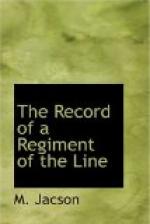On the following morning a force consisting of Devons, Manchesters, Gordons, South African Light Horse, one field battery, and the howitzers, advanced from Van Wycks Vlei under General W. Kitchener, for the purpose of reconnoitring and driving some Boers off the hills east of General Buller’s camp, so that the road for the next day’s march might be cleared of the enemy. A large number of Boers was seen in the direction of Carolina, and it was supposed that Chris. Botha’s force was opposed to the column. The Manchester Regiment led the advance, supported by the Devon Regiment. The former, on crossing a nek to a low underlying hill, came under a heavy rifle fire from the Boers below and across the valley, and lost two killed and nine wounded. The force returned to camp at 6 p.m.
On the following day Buller’s army advanced to Geluk, some five or six miles, the battalion with the Gordons and mounted troops of Dundonald’s Brigade, acting as rear-guard. A very difficult spruit, with steep sides, was crossed, and the high hills on the further side occupied. These had been held by the Boers in strength, but they had retired on Buller’s approach. As soon as the infantry of the rear-guard had arrived in camp, the mounted troops of the rear-guard were attacked rather sharply, but they managed to hold their own and to beat off the Boers. Two companies of the Liverpool Regiment, who formed part of the advance guard, fell into an ambush and lost considerably, leaving, it was reported, some eighty men either killed, wounded, or prisoners in the hands of the Boers. Shortly after arrival in camp, five companies of the Regiment were sent out on outpost duty, taking up a short line and entrenching—two companies were entrenched in front and furnished sentries, with three companies entrenched in rear in support.
On August 24th and 25th the force stood fast, exchanging occasional big gun and musketry fire with the Boers. Information was received that Lord Roberts had entered Belfast on the 24th, thus practically joining hands with Sir Redvers Buller.
The position taken up by the Boers already referred to, an immensely powerful one, straddled the Pretoria-Lorenzo railway east of Belfast and west of Machadodorp. Botha had taken up a front of some fifty miles in length, and his force numbered about 5000 men. His right rested on the broken mountainous country of Elandskloof to the north, and his left on the mountains overlooking the Komati to the south. His centre was at Bergendal Farm and the rugged and precipitous hills in the rear of the farm, through which wound the railway and road, his line of retreat, quite concealed from the fire and view of the British force. On the extreme left a big gun with two or three smaller pieces were mounted, but these were useless to give much support to the centre, as they were too distant. The line of retreat to Komati Poort, which, from the nature of the country, could not be threatened except by an extended movement round the north or south, lay along the Belfast-Machadodorp road and the railway line.




